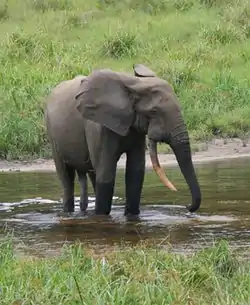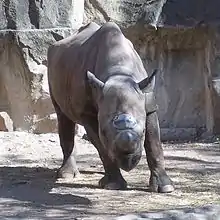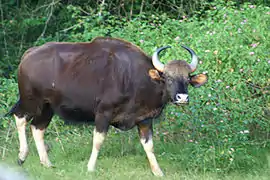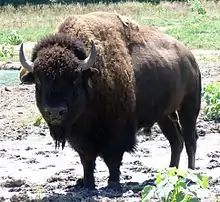List of heaviest land mammals
The heaviest land mammal is the African bush elephant which has a weight of up to 5.4 tonnes (6 short tons).[1] This enormous mammal measures 10-13 ft at the shoulder and consumes around 230 kilograms (500 lb) of vegetation a day. The elephant possesses a set of tusks that grow continuously throughout its life. These tusks have the potential to reach 2.7 m (9 ft) in length, although they are most commonly recorded at a length of 0.6–0.9 metres (2.0–3.0 ft). The average walking speed of an elephant is 7.2 km/h (4.5 mph), but they can run at recorded speeds of up to 24 km/h (15 mph).[2]
Heaviest extant land mammals
| Rank | Name | Image | Family | Taxonomy Classification | Mass[Note 1] |
|---|---|---|---|---|---|
| 1 | African bush elephant |  |
Elephantidae | Loxodonta africana | 5,200–6,900 kg (11,500–15,200 lb)[3] |
| 2 | Asian elephant | .jpg.webp) |
Elephantidae | Elephas maximus indicus, E. m. maximus, E. m. sumatranus, E. m. borneensis | 3,500–4,600 kg (7,700–10,100 lb)[3] |
| 3 | White rhinoceros | Rhinocerotidae | Ceratotherium simum cottoni, C. s. simum | 3,200–3,600 kg (7,100–7,900 lb)[4] | |
| 4 | Indian rhinoceros | Rhinocerotidae | Rhinoceros unicornis | 2,070–2,132 kg (4,564–4,700 lb)[5] | |
| 5 | African forest elephant |  |
Elephantidae | Loxodonta cyclotis | 1,700–2,300 kg (3,700–5,100 lb)[3] |
| 6 | Black rhinoceros |  |
Rhinocerotidae | Diceros bicornis minor, D. b. michaeli, D. b. longipes | 854.6–2,896 kg (1,884–6,385 lb)[6] |
| 7 | Hippopotamus | Hippopotamidae | Hippopotamus amphibius amphibius, H. a. kiboko, H. a. capensis, H. a. tschadensis, H. a. constrictus | 1,210–2,001 kg (2,668–4,411 lb)[7] | |
| 8 | Giraffe |  | Giraffidae | Giraffa camelopardalis camelopardalis, G. c. reticulata, G. c. angolensis, G. c. antiquorum, G. c. tippelskirchi, G. c. rothschildi, G. c. giraffa, G. c. thornicrofti, G. c. peralta | 849–1,395 kg (1,872–3,075 lb)[8] |
| 9 | Gaur |  | Bovidae | Bos gaurus gaurus, B. g. readei, B. g. hubbacki | 590–941 kg (1,301–2,075 lb)[9] |
| 10 | Wild water buffalo | _(cropped).jpg.webp) | Bovidae | Bubalus arnee[Note 2] | 600–1,200 kg (1,300–2,600 lb)[11][10] |
| 11 | Cape buffalo | Bovidae | Syncerus caffer caffer, S. c. nanus, S. c. brachyceros, S. c. aequinoctialis, S. c. mathewsi | 639.6–835.1 kg (1,410–1,841 lb)[12] | |
| 12 | American bison |  | Bovidae | Bison bison | 544–907 kg (1,199–2,000 lb)[13] |
Notes
- Entries are ordered by the median or mean body mass (in that order of preference), if available, or otherwise by the geometric mean of the body mass range limits.
- The domestic water buffalo (Bubalus bubalis) also occurs as feral populations, sometimes in sympatry with Bubalus arnee.[10]
References
- ©G.Ellis/GLOBIO.org;Animals: The Animal Kingdom; Largest Living Animal on Land Archived 2012-04-25 at the Wayback Machine Retrieved 2011
- Stanford News Service Stanford News Service Retrieved April 3, 2016
- Larramendi, A. (2015). "Proboscideans: Shoulder Height, Body Mass and Shape" (PDF). Acta Palaeontologica Polonica. doi:10.4202/app.00136.2014. S2CID 2092950. Retrieved 23 May 2020. This is the range for 90% of the male population; see Table 8.
- Groves, C.P. (1972). "Ceratotherium simum". Mammalian Species (8): 1–6. doi:10.2307/3503966. JSTOR 3503966. See page 1.
- Laurie, W.A.; Lang, E.M.; Groves, C.P. (1983). "Rhinoceros unicornis". Mammalian Species (211): 1–6. doi:10.2307/3504002. JSTOR 3504002. Weights are for captive males; see page 1.
- Hillman-Smith, A.K.K..; Groves, C.P. (1994). "Diceros bicornis". Mammalian Species (455): 1–8. doi:10.2307/3504292. JSTOR 3504292. See page 2.
- Weston, E.M.; Lister, A.M. (2009). "Insular dwarfism in hippos and a model for brain size reduction in Homo floresiensis". Nature. 459 (7243): 85–88. doi:10.1038/nature07922. PMC 2679980. PMID 19424156. Adult range (males plus females; see Supplementary Discussion on page 15 of Supplementary Material); note mean mass = 1,495 kg.
- Hall-Martin, A.J. (1977). "Giraffe Weight Estimation Using Dissected Leg Weight and Body Measurements". The Journal of Wildlife Management. 41 (4): 740–745. doi:10.2307/3799999. JSTOR 3799999. Male weight range, from Table 1.
- Ahrestani, F.S. (2018). "Bos frontalis and Bos gaurus (Artiodactyla: Bovidae)". Mammalian Species. 50 (959): 34–50. doi:10.1093/mspecies/sey004. Wild male range, from article's 4th page; note median mass = 864 kg.
- Aryal, A.; Shrestha, T.K.; Ram, A.; Frey, W.; Groves, C.; Hemmer, H.; Dhakal, M.; Koirala, R.J.; Heinen, J.; Raubenheimer, D. (2011). "Call to conserve the Wild Water Buffalo (Bubalus arnee) in Nepal" (PDF). International Journal of Conservation Science. 2 (4): 261–268. Retrieved 2020-05-25. See page 262.
- Ahrestani, F.S.; Heitkönig, I.M.A.; Matsubayashi, H.; Prins, H.H.T. (2016). "Grazing and Browsing by Large Herbivores in South and Southeast Asia" (PDF). In Ahrestani, F.S.; Sankaran, M. (eds.). The Ecology of Large Herbivores in South and Southeast Asia. Ecological Studies : Analysis and Synthesis. Ecological Studies. 225. Springer Netherlands. pp. 99–120. doi:10.1007/978-94-017-7570-0_4. ISBN 978-94-017-7568-7. ISSN 0070-8356. Retrieved 2020-05-25. See page 104.
- Pienaar, U. de V. (1969). "Observation on developmental biology, growth and some aspects of the population ecology of the African Buffalo (Syncerus caffer caffer Sparrman) in the Kruger National Park". Koedoe. 12 (1). doi:10.4102/koedoe.v12i1.745. ISSN 2071-0771. Combined adult male range for Kruger National Park, South Africa (639.6-767.5 kg; Table 1, page ~56) and East Africa (678.6-835.1 kg; page 36)
- Meagher, M. (1986). "Bison bison". Mammalian Species (266): 1–8. doi:10.1093/mspecies/266.1. JSTOR 3504019. Male weight range, page 1.
External links
| The Wikibook Dichotomous Key has a page on the topic of: Mammalia |
- BBC Wildlife Finder – video clips from the BBC's natural history archive
- GlobalTwitcher.com – All species in the world with distribution maps and images
- Paleocene Mammals, a site covering the rise of the mammals, paleocene-mammals.de
- Evolution of Mammals, a brief introduction to early mammals, enchantedlearning.com
This article is issued from Wikipedia. The text is licensed under Creative Commons - Attribution - Sharealike. Additional terms may apply for the media files.